Jing Zhu
DISCO Balances the Scales: Adaptive Domain- and Difficulty-Aware Reinforcement Learning on Imbalanced Data
May 21, 2025Abstract:Large Language Models (LLMs) are increasingly aligned with human preferences through Reinforcement Learning from Human Feedback (RLHF). Among RLHF methods, Group Relative Policy Optimization (GRPO) has gained attention for its simplicity and strong performance, notably eliminating the need for a learned value function. However, GRPO implicitly assumes a balanced domain distribution and uniform semantic alignment across groups - assumptions that rarely hold in real-world datasets. When applied to multi-domain, imbalanced data, GRPO disproportionately optimizes for dominant domains, neglecting underrepresented ones and resulting in poor generalization and fairness. We propose Domain-Informed Self-Consistency Policy Optimization (DISCO), a principled extension to GRPO that addresses inter-group imbalance with two key innovations. Domain-aware reward scaling counteracts frequency bias by reweighting optimization based on domain prevalence. Difficulty-aware reward scaling leverages prompt-level self-consistency to identify and prioritize uncertain prompts that offer greater learning value. Together, these strategies promote more equitable and effective policy learning across domains. Extensive experiments across multiple LLMs and skewed training distributions show that DISCO improves generalization, outperforms existing GRPO variants by 5% on Qwen3 models, and sets new state-of-the-art results on multi-domain alignment benchmarks.
Hybrid Beamforming for RIS-Assisted Multiuser Fluid Antenna Systems
Apr 12, 2025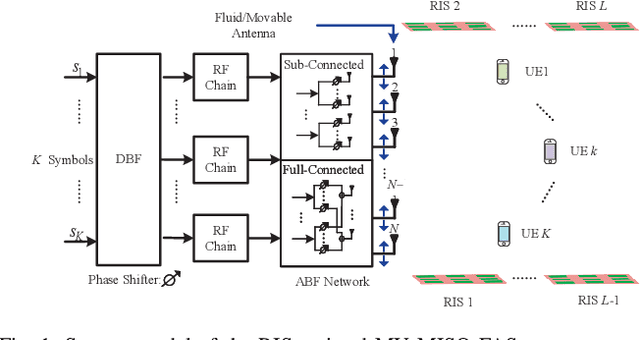
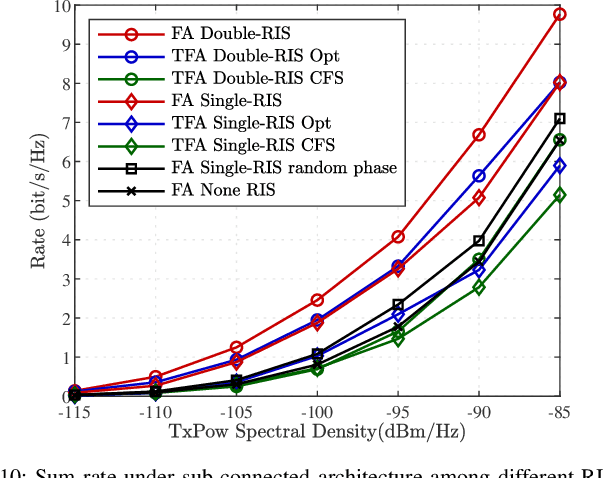
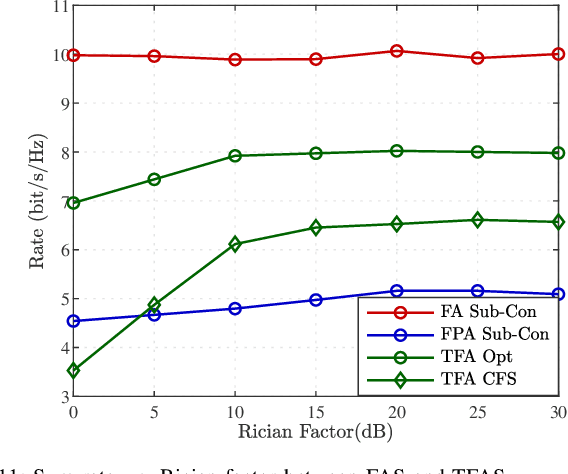
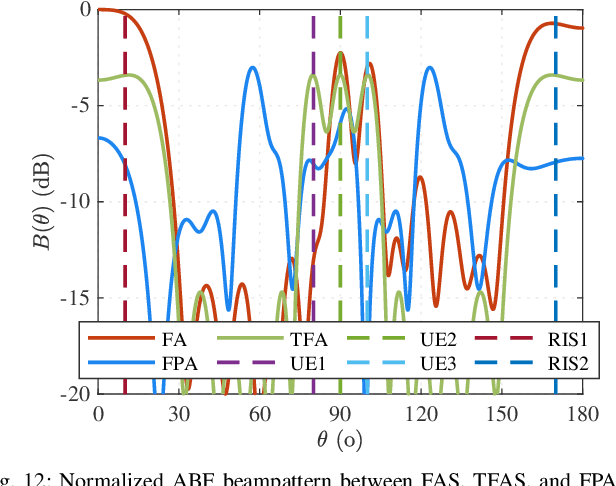
Abstract:Recent advances in reconfigurable antennas have led to the new concept of the fluid antenna system (FAS) for shape and position flexibility, as another degree of freedom for wireless communication enhancement. This paper explores the integration of a transmit FAS array for hybrid beamforming (HBF) into a reconfigurable intelligent surface (RIS)-assisted communication architecture for multiuser communications in the downlink, corresponding to the downlink RIS-assisted multiuser multiple-input single-output (MISO) FAS model (Tx RIS-assisted-MISO-FAS). By considering Rician channel fading, we formulate a sum-rate maximization optimization problem to alternately optimize the HBF matrix, the RIS phase-shift matrix, and the FAS position. Due to the strong coupling of multiple optimization variables, the multi-fractional summation in the sum-rate expression, the modulus-1 limitation of analog phase shifters and RIS, and the antenna position variables appearing in the exponent, this problem is highly non-convex, which is addressed through the block coordinate descent (BCD) framework in conjunction with semidefinite relaxation (SDR) and majorization-minimization (MM) methods. To reduce the computational complexity, we then propose a low-complexity grating-lobe (GL)-based telescopic-FAS (TFA) with multiple delicately deployed RISs under the sub-connected HBF architecture and the line-of-sight (LoS)-dominant channel condition, to allow closed-form solutions for the HBF and TFA position. Our simulation results illustrate that the former optimization scheme significantly enhances the achievable rate of the proposed system, while the GL-based TFA scheme also provides a considerable gain over conventional fixed-position antenna (FPA) systems, requiring statistical channel state information (CSI) only and with low computational complexity.
Beyond Unimodal Boundaries: Generative Recommendation with Multimodal Semantics
Mar 30, 2025Abstract:Generative recommendation (GR) has become a powerful paradigm in recommendation systems that implicitly links modality and semantics to item representation, in contrast to previous methods that relied on non-semantic item identifiers in autoregressive models. However, previous research has predominantly treated modalities in isolation, typically assuming item content is unimodal (usually text). We argue that this is a significant limitation given the rich, multimodal nature of real-world data and the potential sensitivity of GR models to modality choices and usage. Our work aims to explore the critical problem of Multimodal Generative Recommendation (MGR), highlighting the importance of modality choices in GR nframeworks. We reveal that GR models are particularly sensitive to different modalities and examine the challenges in achieving effective GR when multiple modalities are available. By evaluating design strategies for effectively leveraging multiple modalities, we identify key challenges and introduce MGR-LF++, an enhanced late fusion framework that employs contrastive modality alignment and special tokens to denote different modalities, achieving a performance improvement of over 20% compared to single-modality alternatives.
Amplitude-Domain Reflection Modulation for Active RIS-Assisted Wireless Communications
Mar 27, 2025Abstract:In this paper, we propose a novel active reconfigurable intelligent surface (RIS)-assisted amplitude-domain reflection modulation (ADRM) transmission scheme, termed as ARIS-ADRM. This innovative approach leverages the additional degree of freedom (DoF) provided by the amplitude domain of the active RIS to perform index modulation (IM), thereby enhancing spectral efficiency (SE) without increasing the costs associated with additional radio frequency (RF) chains. Specifically, the ARIS-ADRM scheme transmits information bits through both the modulation symbol and the index of active RIS amplitude allocation patterns (AAPs). To evaluate the performance of the proposed ARIS-ADRM scheme, we provide an achievable rate analysis and derive a closed-form expression for the upper bound on the average bit error probability (ABEP). Furthermore, we formulate an optimization problem to construct the AAP codebook, aiming to minimize the ABEP. Simulation results demonstrate that the proposed scheme significantly improves error performance under the same SE conditions compared to its benchmarks. This improvement is due to its ability to flexibly adapt the transmission rate by fully exploiting the amplitude domain DoF provided by the active RIS.
Joint Sparse Graph for Enhanced MIMO-AFDM Receiver Design
Mar 24, 2025Abstract:Affine frequency division multiplexing (AFDM) is a promising chirp-assisted multicarrier waveform for future high-mobility communications. This paper is devoted to enhanced receiver design for multiple input and multiple output AFDM (MIMO-AFDM) systems. Firstly, we introduce a unified variational inference (VI) approach to approximate the target posterior distribution, under which the belief propagation (BP) and expectation propagation (EP)-based algorithms are derived. As both VI-based detection and low-density parity-check (LDPC) decoding can be expressed by bipartite graphs in MIMO-AFDM systems, we construct a joint sparse graph (JSG) by merging the graphs of these two for low-complexity receiver design. Then, based on this graph model, we present the detailed message propagation of the proposed JSG. Additionally, we propose an enhanced JSG (E-JSG) receiver based on the linear constellation encoding model. The proposed E-JSG eliminates the need for interleavers, de-interleavers, and log-likelihood ratio transformations, thus leading to concurrent detection and decoding over the integrated sparse graph. To further reduce detection complexity, we introduce a sparse channel method by approaximating multiple graph edges with insignificant channel coefficients into a single edge on the VI graph. Simulation results show the superiority of the proposed receivers in terms of computational complexity, detection and decoding latency, and error rate performance compared to the conventional ones.
Single Sparse Graph Enhanced Expectation Propagation Algorithm Design for Uplink MIMO-SCMA
Mar 17, 2025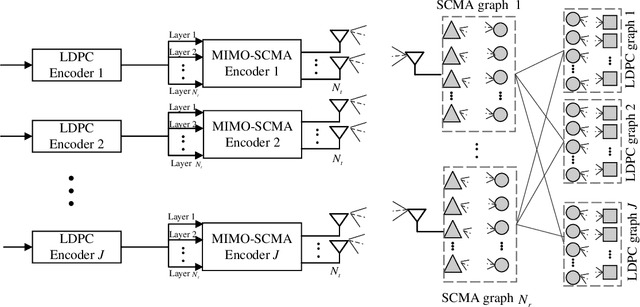
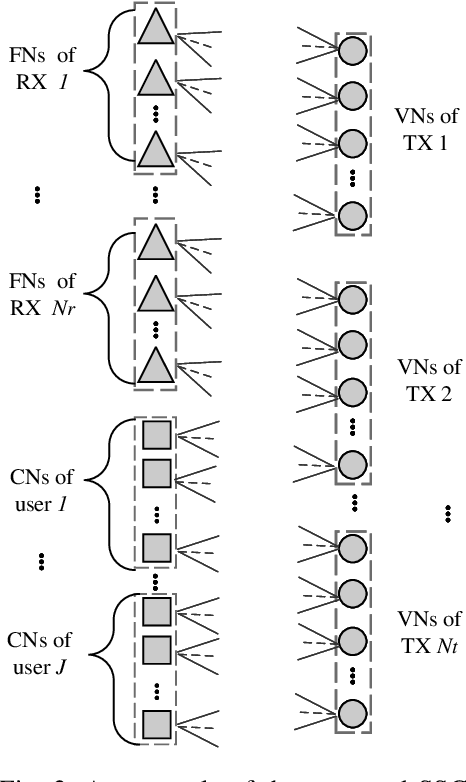
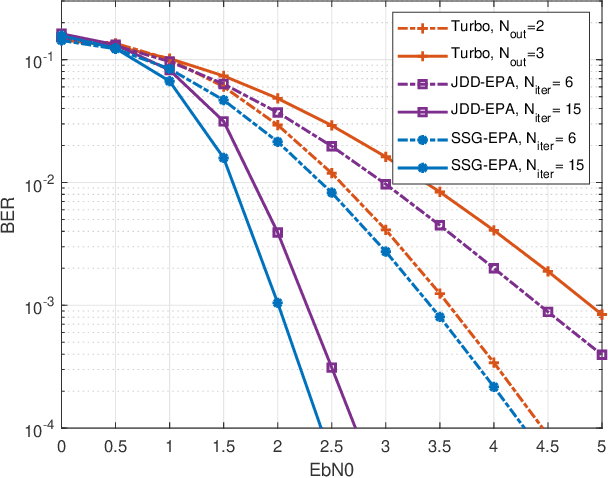
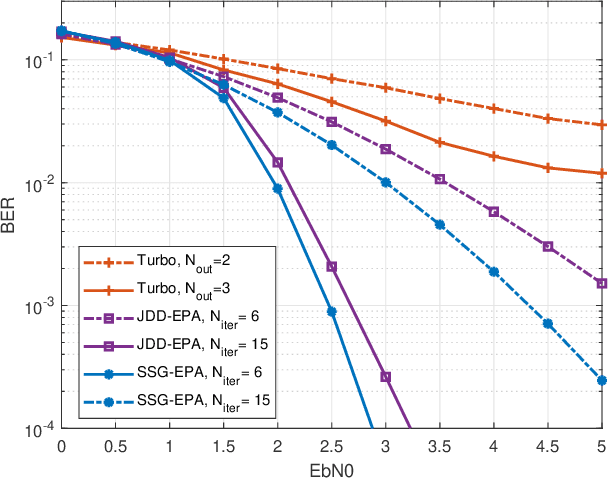
Abstract:Sparse code multiple access (SCMA) and multiple input multiple output (MIMO) are considered as two efficient techniques to provide both massive connectivity and high spectrum efficiency for future machine-type wireless networks. This paper proposes a single sparse graph (SSG) enhanced expectation propagation algorithm (EPA) receiver, referred to as SSG-EPA, for uplink MIMO-SCMA systems. Firstly, we reformulate the sparse codebook mapping process using a linear encoding model, which transforms the variable nodes (VNs) of SCMA from symbol-level to bit-level VNs. Such transformation facilitates the integration of the VNs of SCMA and low-density parity-check (LDPC), thereby emerging the SCMA and LDPC graphs into a SSG. Subsequently, to further reduce the detection complexity, the message propagation between SCMA VNs and function nodes (FNs) are designed based on EPA principles. Different from the existing iterative detection and decoding (IDD) structure, the proposed EPA-SSG allows a simultaneously detection and decoding at each iteration, and eliminates the use of interleavers, de-interleavers, symbol-to-bit, and bit-to-symbol LLR transformations. Simulation results show that the proposed SSG-EPA achieves better error rate performance compared to the state-of-the-art schemes.
Advanced Nonlinear SCMA Codebook Design Based on Lattice Constellations
Nov 13, 2024Abstract:The design of efficient sparse codebooks in sparse code multiple access (SCMA) system have attracted tremendous research attention in the past few years. This paper proposes a novel nonlinear SCMA (NL-SCMA) that can subsume the conventional SCMA system which is referred to as linear SCMA, as special cases for downlink channels. This innovative approach allows a direct mapping of users' messages to a superimposed codeword for transmission, eliminating the need of a codebook for each user. This mapping is referred to as nonlinear mapping (codebook) in this paper. Hence, the primary objective is to design the nonlinear mapping, rather than the linear codebook for each user. We leverage the Lattice constellation to design the superimposed constellation due to its advantages such as the minimum Euclidean distance (MED), constellation volume, design flexibility and shape gain. Then, by analyzing the error patterns of the Lattice-designed superimposed codewords with the aid of the pair-wise error probability, it is found that the MED of the proposed nonlinear codebook is lower bounded by the ``single error pattern''. To this end, an error pattern-inspired codebook design is proposed, which can achieve large MEDs of the nonlinear codebooks. Numerical results show that the proposed codebooks can achieve lower error rate performance over both Gaussian and Rayleigh fading channels than the-state-of-the-art linear codebooks.
NetworkGym: Reinforcement Learning Environments for Multi-Access Traffic Management in Network Simulation
Oct 30, 2024



Abstract:Mobile devices such as smartphones, laptops, and tablets can often connect to multiple access networks (e.g., Wi-Fi, LTE, and 5G) simultaneously. Recent advancements facilitate seamless integration of these connections below the transport layer, enhancing the experience for apps that lack inherent multi-path support. This optimization hinges on dynamically determining the traffic distribution across networks for each device, a process referred to as \textit{multi-access traffic splitting}. This paper introduces \textit{NetworkGym}, a high-fidelity network environment simulator that facilitates generating multiple network traffic flows and multi-access traffic splitting. This simulator facilitates training and evaluating different RL-based solutions for the multi-access traffic splitting problem. Our initial explorations demonstrate that the majority of existing state-of-the-art offline RL algorithms (e.g. CQL) fail to outperform certain hand-crafted heuristic policies on average. This illustrates the urgent need to evaluate offline RL algorithms against a broader range of benchmarks, rather than relying solely on popular ones such as D4RL. We also propose an extension to the TD3+BC algorithm, named Pessimistic TD3 (PTD3), and demonstrate that it outperforms many state-of-the-art offline RL algorithms. PTD3's behavioral constraint mechanism, which relies on value-function pessimism, is theoretically motivated and relatively simple to implement.
On the Impact of Feature Heterophily on Link Prediction with Graph Neural Networks
Sep 26, 2024
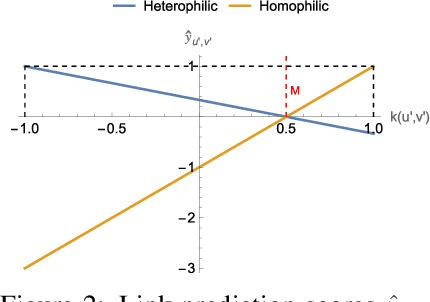
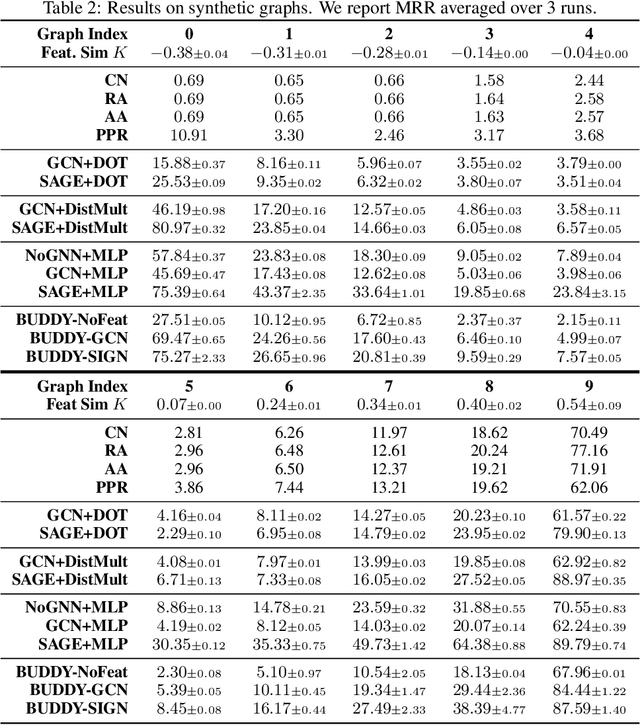
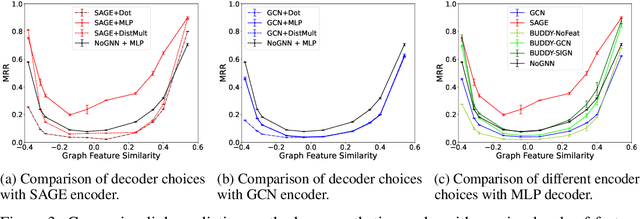
Abstract:Heterophily, or the tendency of connected nodes in networks to have different class labels or dissimilar features, has been identified as challenging for many Graph Neural Network (GNN) models. While the challenges of applying GNNs for node classification when class labels display strong heterophily are well understood, it is unclear how heterophily affects GNN performance in other important graph learning tasks where class labels are not available. In this work, we focus on the link prediction task and systematically analyze the impact of heterophily in node features on GNN performance. Theoretically, we first introduce formal definitions of homophilic and heterophilic link prediction tasks, and present a theoretical framework that highlights the different optimizations needed for the respective tasks. We then analyze how different link prediction encoders and decoders adapt to varying levels of feature homophily and introduce designs for improved performance. Our empirical analysis on a variety of synthetic and real-world datasets confirms our theoretical insights and highlights the importance of adopting learnable decoders and GNN encoders with ego- and neighbor-embedding separation in message passing for link prediction tasks beyond homophily.
Multimodal Graph Benchmark
Jun 24, 2024



Abstract:Associating unstructured data with structured information is crucial for real-world tasks that require relevance search. However, existing graph learning benchmarks often overlook the rich semantic information associate with each node. To bridge such gap, we introduce the Multimodal Graph Benchmark (MM-GRAPH), the first comprehensive multi-modal graph benchmark that incorporates both textual and visual information. MM-GRAPH surpasses previous efforts, which have primarily focused on text-attributed graphs with various connectivity patterns. MM-GRAPH consists of five graph learning datasets of various scales that are appropriate for different learning tasks. Their multimodal node features, enabling a more comprehensive evaluation of graph learning algorithms in real-world scenarios. To facilitate research on multimodal graph learning, we further provide an extensive study on the performance of various graph neural networks in the presence of features from various modalities. MM-GRAPH aims to foster research on multimodal graph learning and drive the development of more advanced and robust graph learning algorithms. By providing a diverse set of datasets and benchmarks, MM-GRAPH enables researchers to evaluate and compare their models in realistic settings, ultimately leading to improved performance on real-world applications that rely on multimodal graph data.
 Add to Chrome
Add to Chrome Add to Firefox
Add to Firefox Add to Edge
Add to Edge